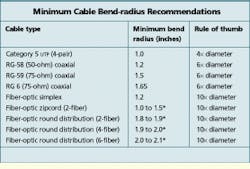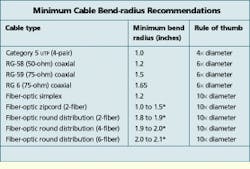The case for a 2-inch cable bend radius
There`s a misperception that the Category 5 utp 1-inch bend-radius standard applies to all cable.
Kent McCord / The Wiremold Co.
The structured-cabling industry is witnessing several major trends, including the increased use of accessible, flexible cable-management systems that facilitate moves, adds, and changes. While Category 5 (and beyond) unshielded twisted-pair (utp) cable continues to be a highly popular medium, fiber-optic cable also has become a major influence in premises cabling. In fact, some studies indicate that fiber cable soon will rival utp copper cable in fiber-to-the-desk installations.
Installations of optical fiber through cable-management systems, such as raceways and in-floor systems, have raised questions about the radius at the corners of these systems. There is a common belief that a cable bend radius of 1 inch is sufficient to ensure optimal performance of all high-performance communications cable. While this bend radius has been determined adequate specifically for 4-pair Category 5 utp cable, it is not sufficient industry-wide for other types of copper media, as well as for most types of fiber-optic cable recommended for use in horizontal cabling.
In search of a universal standard
There is no industry standard for cable bend radius that covers all types of high-performance communications cable used in horizontal cabling. But the trend toward fiber-to-the-desk and the increased use of flexible cable-management systems have created a need to establish a new industry standard for communications pathways to meet the demands of all end-to-end cabling systems, both copper and fiber. An industry-wide standard should address cable bend radius, the ability to mount typical communications connectors, and the provision for fiber storage loops at activation points. The standard cable bend radius should be 2 inches for cable-management systems in horizontal installations.
In any cable installation, the primary concern should be to safeguard the integrity of data transmission through the cable. Physical protection for the cable is an obvious necessity. More subtle, however, is the need to maintain the recommended cable bend radius at all times and in all locations. The reasons for this requirement differ depending on whether the cable is copper or fiber.
Copper cable can support high-speed, high-bandwidth data transmission largely due to the precision with which the individual pairs of conductors are twisted together. Excessive bending of the cable can disturb the critical geometry of the twists, reducing performance through increased sensitivity to external noise and increased near-end crosstalk within the cable. In addition, long-term damage to the cable jacketing and insulating material can result from excess bending stress.
The effect of bending on fiber is completely different. When a fiber cable is bent excessively, the optical signal within the cable will refract, or escape, through the fiber cladding. Bending the cable can also permanently damage the fiber by causing micro cracks, especially during cable installation when pulling forces occur. The result is known as bend loss, or increased attenuation in the fiber that equates to a loss of signal strength and potentially compromised data.
Bend-radius requirements
Cable bend-radius requirements for different types of communications cable have been developed by various cabling-industry groups, cable manufacturers, industry standards bodies, such as the Telecommunications Industry Association (tia--Arlington, VA) and Electronic Industries Alliance (eia--Arlington, VA), and independent training organizations such as bicsi (Tampa, FL). Industry "rules of thumb" have emerged from these specifications that express bend radius as a multiple of cable diameter. These rules of thumb have been widely accepted and, in fact, are used in bicsi training courses.
The often-quoted 1-inch minimum cable bend radius is derived from the tia/eia-568a Commercial Building Telecommunications Cabling Standard test for 4-pair utp Category 5 cable, which ensures that the cable "shall withstand a bend radius of 25.4 millimeters (1 inch) at a temperature of -20oC without jacket or insulation cracking." This standard is not a requirement for coaxial or fiber-optic cable.
Although the minimum bend radius allowable for a fiber- optic cable is not governed by an industry standard, it is predicated on the specifications of individual cable manufacturers. Because cable-construction methodologies and specifications are similar among manufacturers, the bend-radius specifications also are similar, and a de facto standard of 10 times the cable diameter has evolved for fiber-optic cables.
Manufacturers of fiber-optic cable also publish a second bend radius, commonly termed the "short-term" or "loaded" bend radius, which ranges from 15 to 20 times the cable diameter. This larger bend radius often causes confusion in the field. Although the loaded radius would seem to apply when there is tension on the cable, according to cable manufacturers` assurances, the published long-term 10-times-the-cable-diameter figure is adequate for pulling fiber cable under normal installation tensions. The loaded bend radius applies only in cases where the pulling tension approaches the maximum tensile load of the cable. A typical 2-fiber plenum cable has a maximum tensile rating of 100 pounds, far higher than what would be expected during the installation of premises cabling.
But even the 10-times-cable-diameter figure equates to a bend radius larger than 1 inch for most fiber-optic cables. This means that cable-management products developed and promoted for use with Category 5 cable may not maintain the specified bend radius for most types of fiber-optic cable.
Calling for 2 inches
An analysis of manufacturers` published cable bend-radius specifications indicates that a 2-inch bend radius is the minimum that will accommodate the full range of cabling media likely to be installed between telecommunications closets (TCs) and workstations.
The need for a 2-inch bend radius is driven by round distribution cable--the type of fiber-optic cable designed and recommended for premises wiring in a horizontal network. Simplex and zipcord allow a much tighter bend radius, but are primarily recommended for patch cords and crossconnects within TCs. It must be noted that a 2-inch bend radius is sufficient only for fiber-optic cable with up to 6 strands of fiber. It is not suitable for larger-pair-count utp and fiber-optic cable used in backbone applications.
Employing a 2-inch cable bend radius offers significant advantages. Not only is a cable-management system that maintains this bend radius at all the corners fully compliant with the tia/eia-568a minimum bend-radius standard for Category 5 cable, but the system also can accept any type of horizontal fiber-optic cable with no additional fittings and no threat to the integrity of data transmission. Thus, cabling plants that use Category 5 cabling today can be upgraded to fiber-optic cable quickly and efficiently if they have a 2-inch bend radius.
Yet another advantage of a 2-inch cable bend radius is ease of installation. Because several major manufacturers of fiber-optic cable say that the long-term bend radius is acceptable under normal pulling loads, installers can safely pull fiber-optic cable around corners without fear of bend loss. It must be stressed that this practice is safe only if the pulling tension is well within the published tensile limits of the cable.
The proposed 2-inch cable bend-radius standard is bas-ed on the realities of the structured-cabling marketplace. Copper utp cable and fiber-optic cable continue to vie for dominance in a rapidly growing premises-cabling market. Cable-management systems, which offer excellent flexibility, must be able to accept fiber-optic or copper cable without the need for costly and time-consuming retrofits. Data supplied by manufacturers of fiber-optic cable clearly show that a 2-inch cable bend radius should be the standard for communications pathways that accommodate copper or fiber-optic cable.
Kent McCord is a senior design engineer with The Wiremold Co. (West Hartford, CT).

